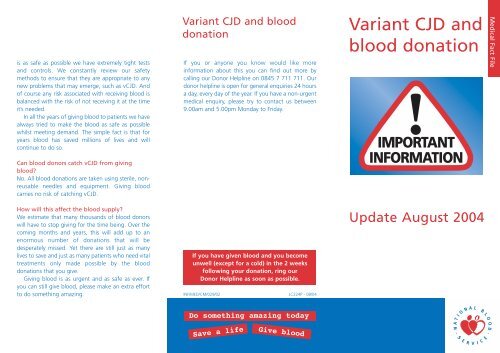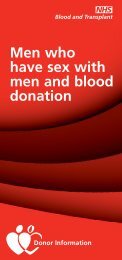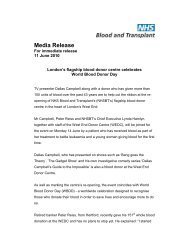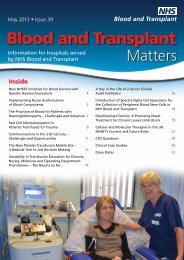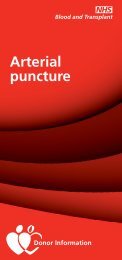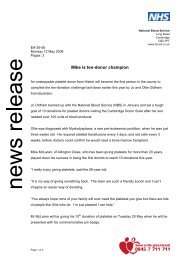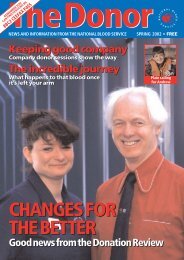Variant CJD and blood donation (PDF, 62K) - National Blood Service
Variant CJD and blood donation (PDF, 62K) - National Blood Service
Variant CJD and blood donation (PDF, 62K) - National Blood Service
Create successful ePaper yourself
Turn your PDF publications into a flip-book with our unique Google optimized e-Paper software.
is as safe as possible we have extremely tight tests<br />
<strong>and</strong> controls. We constantly review our safety<br />
methods to ensure that they are appropriate to any<br />
new problems that may emerge, such as v<strong>CJD</strong>. And<br />
of course any risk associated with receiving <strong>blood</strong> is<br />
balanced with the risk of not receiving it at the time<br />
it’s needed.<br />
In all the years of giving <strong>blood</strong> to patients we have<br />
always tried to make the <strong>blood</strong> as safe as possible<br />
whilst meeting dem<strong>and</strong>. The simple fact is that for<br />
years <strong>blood</strong> has saved millions of lives <strong>and</strong> will<br />
continue to do so.<br />
Can <strong>blood</strong> donors catch v<strong>CJD</strong> from giving<br />
<strong>blood</strong><br />
No. All <strong>blood</strong> <strong>donation</strong>s are taken using sterile, nonreusable<br />
needles <strong>and</strong> equipment. Giving <strong>blood</strong><br />
carries no risk of catching v<strong>CJD</strong>.<br />
<strong>Variant</strong> <strong>CJD</strong> <strong>and</strong> <strong>blood</strong><br />
<strong>donation</strong><br />
If you or anyone you know would like more<br />
information about this you can find out more by<br />
calling our Donor Helpline on 0845 7 711 711. Our<br />
donor helpline is open for general enquiries 24 hours<br />
a day, every day of the year. If you have a non-urgent<br />
medical enquiry, please try to contact us between<br />
9.00am <strong>and</strong> 5.00pm Monday to Friday.<br />
<strong>Variant</strong> <strong>CJD</strong> <strong>and</strong><br />
<strong>blood</strong> <strong>donation</strong><br />
IMPORTANT<br />
INFORMATION<br />
Medical Fact File<br />
How will this affect the <strong>blood</strong> supply<br />
We estimate that many thous<strong>and</strong>s of <strong>blood</strong> donors<br />
will have to stop giving for the time being. Over the<br />
coming months <strong>and</strong> years, this will add up to an<br />
enormous number of <strong>donation</strong>s that will be<br />
desperately missed. Yet there are still just as many<br />
lives to save <strong>and</strong> just as many patients who need vital<br />
treatments only made possible by the <strong>blood</strong><br />
<strong>donation</strong>s that you give.<br />
Giving <strong>blood</strong> is as urgent <strong>and</strong> as safe as ever. If<br />
If you have given <strong>blood</strong> <strong>and</strong> you become<br />
unwell (except for a cold) in the 2 weeks<br />
following your <strong>donation</strong>, ring our<br />
Donor Helpline as soon as possible.<br />
you can still give <strong>blood</strong>, please make an extra effort<br />
to do something amazing. INF/MED/CM/029/02 LC224P - 08/04<br />
Update August 2004
Medical Fact File<br />
<strong>Variant</strong> <strong>CJD</strong> <strong>and</strong> <strong>blood</strong><br />
<strong>donation</strong><br />
IMPORTANT<br />
INFORMATION<br />
An extension to the new rule for<br />
<strong>blood</strong> donors<br />
On the 5th April 2004 we<br />
brought in a new precautionary<br />
rule for whole <strong>blood</strong> donors.<br />
Sadly we could no longer accept<br />
<strong>blood</strong> <strong>donation</strong>s from people who have<br />
received <strong>blood</strong> during the course of any medical<br />
treatment or procedure in the UK since 1st<br />
January 1980.<br />
From the 2nd August 2004 we decided to<br />
extend this rule to include anyone who is<br />
unsure if they have had a transfusion since<br />
1980. This rule now also includes all our platelet<br />
<strong>and</strong> plasma (apheresis) donors who have<br />
received <strong>blood</strong> or think they may have received<br />
<strong>blood</strong> since January 1980.<br />
This new rule has been introduced as a purely<br />
precautionary measure. It aims to reduce the<br />
possible risk of variant <strong>CJD</strong> (v<strong>CJD</strong>) being passed<br />
on from donor to patient.<br />
However, just like our other rules regarding<br />
who can <strong>and</strong> can’t give – things can change. As<br />
new scientific information comes to light, we<br />
will review this situation. This could mean<br />
either continuing this ruling or asking people to<br />
come back. We just don’t know yet.<br />
About v<strong>CJD</strong><br />
Creutzfeldt-Jakob disease (<strong>CJD</strong>) is one of a group of<br />
diseases that affect the central nervous system. <strong>CJD</strong><br />
cases have naturally occurred in several forms for<br />
many years. Fortunately, <strong>CJD</strong> in all its forms is very<br />
rare indeed.<br />
The more recently occurring variant <strong>CJD</strong> (v<strong>CJD</strong>) is<br />
believed to be the consequence of eating<br />
contaminated beef, related to BSE (or mad cow<br />
disease) in UK cattle herds after 1980.<br />
<strong>CJD</strong> is not like a cold, you can’t catch it from<br />
people in the same room. There is no evidence of<br />
transmission by sex or from mother to baby at birth.<br />
However, person to person transmission can occur<br />
during medical procedures. There have been a small<br />
number of confirmed transmissions so far via<br />
instruments, tissue grafts <strong>and</strong> the use of human<br />
derived growth hormones. As receiving <strong>blood</strong> is a<br />
medical procedure, it follows that v<strong>CJD</strong> may infect a<br />
patient via <strong>blood</strong>. There is no definite proof, but it<br />
remains a possibility.<br />
What we are doing about v<strong>CJD</strong><br />
Since 1997 the <strong>Blood</strong> <strong>Service</strong>s of the UK have taken<br />
a number of precautionary measures, just in case:<br />
1. The recall of any <strong>blood</strong> components from donors<br />
who later go on to develop v<strong>CJD</strong><br />
2. The importation of plasma from countries with<br />
few or no cases of BSE to manufacture <strong>blood</strong><br />
products<br />
3. The removal of white cells from the <strong>blood</strong> before<br />
it is transfused (white cells may carry v<strong>CJD</strong><br />
infection)<br />
4. The importation of plasma from countries with<br />
few or no cases of BSE for children born after<br />
January 1996.<br />
It wasn’t until December 2003 that evidence came to<br />
light that a <strong>blood</strong> donor may have transmitted v<strong>CJD</strong><br />
to a patient via a <strong>blood</strong> transfusion. Scientists are not<br />
100% sure that this is the case as it is still possible<br />
that both donor <strong>and</strong> patient separately acquired<br />
v<strong>CJD</strong> by eating contaminated beef.<br />
Even so, in light of this case we are now asking all<br />
donors who have or think they may have received<br />
<strong>blood</strong> in the UK since 1st January 1980 (the date BSE<br />
became present in the UK food chain) to stop giving<br />
<strong>blood</strong>. By doing this we will be excluding a group of<br />
people who have, potentially, a slightly higher<br />
chance of having been exposed to v<strong>CJD</strong> than those<br />
who have not received <strong>blood</strong>.<br />
I know someone that has received <strong>blood</strong>. What<br />
does it mean to their health<br />
People who have received <strong>blood</strong> since 1980 belong<br />
to a large group that together has a potentially<br />
slightly higher risk of exposure to v<strong>CJD</strong> than the<br />
general population.<br />
Just how small this risk is can be seen from the<br />
fact that in the last ten years, UK hospitals have used<br />
23 million units of <strong>blood</strong>, <strong>and</strong> yet the December<br />
2003 case is the first ever recorded. And we are still<br />
not 100% sure that this was an actual transmission.<br />
And yet as small as the risk is, by excluding these<br />
donors we can make the <strong>blood</strong> that patients receive<br />
that little bit safer. We are erring heavily on the side<br />
of caution.<br />
Since 1997, a medical study has identified just a<br />
h<strong>and</strong>ful of patients who have received <strong>blood</strong> from<br />
donors who were well at the time they gave <strong>blood</strong><br />
but some time later went on to develop v<strong>CJD</strong>. All of<br />
those patients have been informed, <strong>and</strong> to date only<br />
one of them has possibly been infected by v<strong>CJD</strong> from<br />
the <strong>blood</strong> they received.<br />
Keeping UK <strong>blood</strong> safe<br />
The UK has an exceptionally good track record of<br />
safe <strong>blood</strong>. Like any medical procedure it does have<br />
a small risk associated with it but to make sure <strong>blood</strong>


